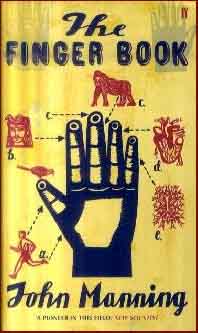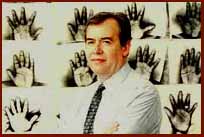|
|
 
|
The science works as follows. In the early stages of pregnancy, foetuses are bombarded with sex hormones (testosterone and oestrogen) that affect the way they develop. Foetuses that are exposed to more testosterone, for instance, have a much better chance of becoming athletically superior to their less testosteronised contemporaries.
The trouble is, there's no accurate way to measure testosterone exposure in the womb. However, we do know that the length of one's ring finger compared with the length of one's index finger provides a reasonably accurate indication. If the ring finger is longer than the index finger, it is likely that the person was exposed to more testosterone in the womb - and that, Manning says, can tell us a great deal.
|
|
The ''finger ratio", he says, is "a living fossil" of the early period of pregnancy. Finger ratios are calculated simply by measuring the index finger of the right hand, then the ring finger, and dividing the former by the latter. Those with a longer ring finger have a ratio of less than 1. This is called the "Casanova pattern". Those with higher, or more feminised ratios, will have ratios greater than 1. The average ratio for men is 0.98.
Perhaps most intriguing is the link between finger ratio and disease. "The theory's quite simple," Manning says. "Our early exposure to testosterone and oes-trogen has a fundamental effect on how organs are formed. That may well affect predisposition in later life to disease."
He is particularly interested in looking at diseases that affect one sex more than the other - or that might progress faster in, say, men than women - and correlating them to finger ratios. "If you look at diseases across the board, they often show sex differences." True, this research is in its infancy, but there are already definite patterns emerging.
|

|
|
Take osteoarthritis, for example. Individuals with masculinised digit ratios [those towards the 0.9 end of the spectrum] tend to present early with osteoarthritis, he says. Another researcher will soon be publishing a study that suggests cervical cancer is more prevalent in women with very feminised ratios. It all sounds a bit alarming.
But Manning cautions us against jumping to unwelcome conclusions. There are many anecdotal exceptions to these rules, he says, and not all of the correlations he has worked on are "copper-bottomed". He has also not yet determined exactly why certain finger ratios should be connected to certain predispositions to disease.
When it comes to sexuality or sporting ability, though, Manning is more confident.
He is "reasonably sure", for instance, that more gay men have feminised finger ratios than straight men. This is an extraordinary claim. "And it's quite a hard one to prove, because certain studies have had it different ways," he admits. "But we did a large study with the BBC recently, and it seemed to show that gay guys are more likely to have had less testosterone exposure. Why that should be so, we don't know."
Manning is also pretty certain that in sports such as long-distance running, football and rugby, masculinised finger ratios are a way of measuring natural talent. So, in the journalistic tradition of conducting deeply unscientific experiments, I drag him and his finger-measuring calliper out to a specialist indoor running track in Cardiff to test his theories on a group of elite athletes.
Three potential sporting stars have agreed to have their fingers measured. They are Fay Pittman, a 25-year-old former gymnast who has switched to multi-event athletics; Dan Turner, a promising 23-year-old footballer, and Richardo Childs, 23, a long jumper. They are all a little jittery. "Of course," Manning says. "No one likes to be told they haven't got a good ratio."
Pittman, who looks far from manly, has an astonishingly low finger ratio of 0.9, indicating high foetal testosterone exposure. It's a classic Casanova pattern. "Well, that is astonishing," Manning says. Pittman shrugs her shoulders and laughs. "It's always nice to know you've got potential," she says.
Turner's and Childs's finger ratios yield more surprising results. Childs's is low - 0.9 - indicating that, like Pittman, he had a high exposure to testosterone in the womb, but Turner's is about average, at 0.97. Sensitive to Turner's feelings, Manning tells him that the last person he measured who had a 0.97 ratio was the footballer Geoff Hurst.
But there's no disguising the footballer's mild disappointment. He brightens up only when the professor points out that finger ratio is just a "probabilistic" indicator and that there are, of course, many other factors, including genetics, at work.
We are then joined by Lynn Davis, the president of UK Athletics and winner of the gold medal for the long jump at the 1964 Olympics in Tokyo. Manning cannot hide his excitement. His calliper shakes as he fumbles with Davis's fingers.
What he finds is a ratio of 0.93, exactly the same as that of Jonathan Edwards, the world-record-breaking British triple-jumper. "Are you saying I could go far?" Davis says, deadpan. "Well, it's never too late for a comeback," Manning replies.
Spotting athletic potential in a man who was at his peak four decades ago is probably a waste of time. But Manning is convinced that finger measurement could be the key to finding the stars of tomorrow. "I'm sure we could look at a group of kids and see which ones had potential to be middle-distance and long-distance runners, where the correlation is very strong," he says.
"My personal opinion is that you could also use this method to spot football talent. The definitive study would be to measure a group of 12-year-old footballers and follow them until the age of 18. We've started studies along those lines in various places, and we're waiting for the data to come through." Davis, in his role as head of UK Athletics, seems to be taking what Manning says seriously. He gratefully accepts a bundle of scientific papers to read later. "Why not?" he says. "If it works, it works. Of course, there are many other factors involved, notably a desire to train and how quickly a person matures."
For now talent-spotting is restricted to more traditional tools, such as stopwatches. But in the future, who knows? If Manning could prove that finger ratios have a direct bearing on sporting ability, then callipers might soon become the must-have accessory for competitive dads.
The Finger Book, by John Manning, is published by Faber & Faber on March 6 at £12.99
Finding your finger ratio:
Place your right hand palm up Measure the length of your index finger, from where it joins your palm to the tip
Measure your ring finger in the same way
Divide the length of the index finger by that of the ring finger to calculate your 'finger ratio'
The average ratio for (white) women is close to 1, The average ratio for (white) men is close to 0.98.
|
|
 
|
|
 Find a Palm Reader in the UK! Find a Palm Reader in the UK!
Related sources:
The Finger Book
What our fingers can tell us
Left Handedness & Finger Asymmetry
Giving Science the Finger
Digit Ratio & Agression
Finger Length & Facial Characteristics
Finger Length & Children's exam results
Finger Length & Osteoarthritis
Pointing a Finger at Sports Success
Double Digits
Talk to the Hand
HAND READING NEWS
|
